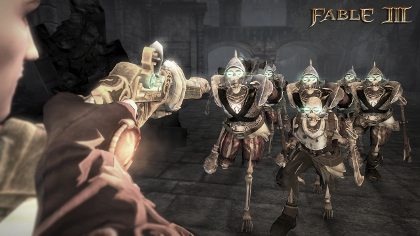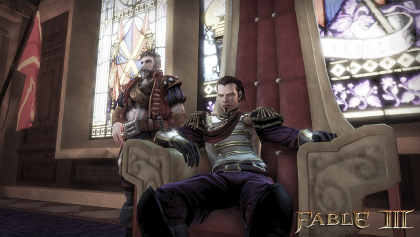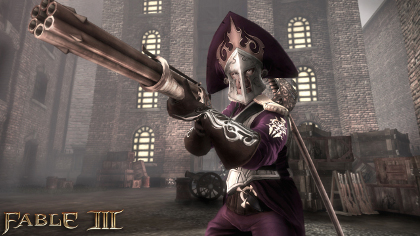Rather brilliantly, how you behave also shapes the weapons at your disposal. Employ the full range of options in conversation with villagers, and the butt of your rifle may sprout silver scrollwork to compliment your silver tongue, while obsessively ranging after buried treasure will dye the barrel a coppery colour. The haft of a hammer might wind itself into arcane tangles if you demonstrate a fondness for fireball spells; a blade steeped in the blood of the innocent may split down the middle to reveal a repulsive meaty core.

Undead. Or as they're known in Fable parlance, Hollow Men. More like hollow characterisations, amirite?
The presence of evolving weaponry removes the need to hoard gear, and helps jazz up the recycled combat system, otherwise in danger of feeling stagnant. Melee strikes, spells, gunplay and evasive rolls each get their own face button, and transiting between styles is as stylishly seamless as ever, but where players of Fable II found a cozy groove, here you’re always thinking about which aspects of a weapon you want to unearth and favouring one or the other approach accordingly.
So much for the smaller details, but what of Fable III’s big new feature, suspiciously absent from this review till now – monarchy? Given the point about empowering the player, surely the prospect of assuming the throne of Albion, holding its hundreds of protean computer personalities to your bosom or mashing them beneath an iron fist, is an automatic plus mark? Not quite, alas. Lionhead’s implementation of the idea is interesting but incomplete.
The moment in which you don the crown is the hinge on which the storyline turns. The first twelve hours chart your hero’s efforts to raise a rebellion against tyrannous elder brother Logan and his industrialist crony Reaver (a role fulsomely filled out by Stephen Fry). This entails travelling to key regions and securing the loyalty of the populace, whether by completing quests, making a lasting impression at street level (hint: fart a lot) or just duffing up the local bad guys. Bowling over hearts and minds earns Guild Seals, which are used to unlock chests containing stat boosts and abilities on the Road to Rule, an eerie, greyscale political allegory presided over by a sexed-up Zoë Wanamaker.
Once you’ve earned enough seals, local bigwigs will pledge their men to your cause, providing you agree to further their region’s interests on taking power. You might be asked to reopen an academy, for instance, or abolish child labour, or restore an ancient forest to its rightful owners. Having deposed Logan, you’re then allowed to choose which – if any – of these promises to fulfil, hearing proposals and counter-proposals in your throne room, and considering the implications for the royal treasury.
The entire kingdom will be reshaped by these decisions, its very geography buckling and re-cohering in the blink of a loading screen. Lakes will be drained in order to mine their beds, or preserved as zones of outstanding natural beauty. Factories may be converted into orphanages, homeless shelters into brothels. You’ll be hailed in the streets of the capital as a saviour, or booed as a tyrant, embraced by old allies, or reviled for your treachery.
As an attempt to put an exclamation mark on the series’ continuing fascination with moral choice, it’s laudably ambitious, and being able to actually call up the world map, set down in some backwater and appraise the fallout lends the business of court an appropriate sense of weight. Trouble is, the weight isn’t given enough time to sink in.
Immediately after seizing the throne a key revelation occurs which, suffice to say, triggers a countdown to a final reckoning, leaving the player only a few opportunities to wave a sceptre before the credits gallop over the horizon. While the consequences of rule or misrule filter down plausibly into the texture of the world itself, this premature closure nips several promising plot threads in the bud. Denied his suit, one character mutters darkly of a second revolution. An intriguing possibility, mate – but Lionhead hasn’t allowed time to complete the cycle. The concluding struggle itself is a disappointment – a waste of what might, given another few pages of script, have been a memorable villain.
If you’re after a pullquote (hello Metacritic), Fable III is a sanded-down Fable II with fewer raw numbers, an even more biting wit and a coronet dangling uneasily from one corner. As an exercise in giving shape to the ego of the person playing it, it’s second to none, but as an attempt to pitch players into the conflicts and compromises of statesmanship, it could use a bit of work.








 Satoru Iwata Video Interview - the late Nintendo president spoke with Kikizo in 2004 as 'Nintendo Revolution' loomed.
Satoru Iwata Video Interview - the late Nintendo president spoke with Kikizo in 2004 as 'Nintendo Revolution' loomed. Kaz Hirai Video Interview - the first of Kikizo's interviews with the man who went on to become global head of Sony.
Kaz Hirai Video Interview - the first of Kikizo's interviews with the man who went on to become global head of Sony. Ed Fries Video Interview - one of Xbox's founders discusses an epic journey from Excel to Xbox.
Ed Fries Video Interview - one of Xbox's founders discusses an epic journey from Excel to Xbox. Yu Suzuki, the Kikizo Interview - we spend time with one of gaming's most revered creators.
Yu Suzuki, the Kikizo Interview - we spend time with one of gaming's most revered creators. Tetris - The Making of an Icon: Alexey Pajitnov and Henk Rogers reveal the fascinating story behind Tetris
Tetris - The Making of an Icon: Alexey Pajitnov and Henk Rogers reveal the fascinating story behind Tetris Rare founders, Chris and Tim Stamper - their only interview? Genuinely 'rare' sit down with founders of the legendary studio.
Rare founders, Chris and Tim Stamper - their only interview? Genuinely 'rare' sit down with founders of the legendary studio. The History of First-Person Shooters - a retrospective, from Maze War to Modern Warfare
The History of First-Person Shooters - a retrospective, from Maze War to Modern Warfare